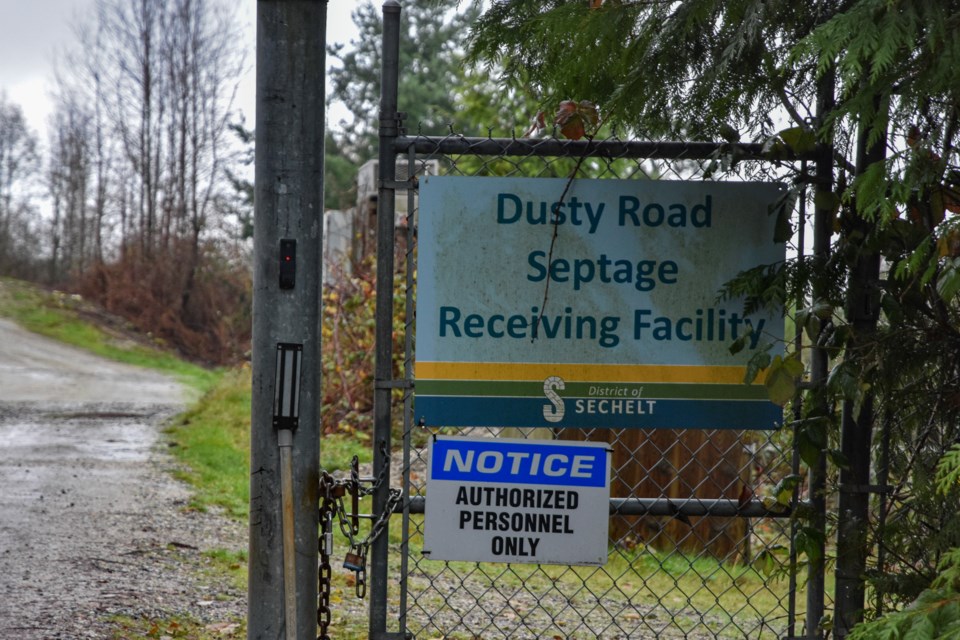Septic waste on the Coast is collected in only one location – and it's running out of space.
An in-depth analysis of septage management is ongoing in the District of Sechelt. Following a request from previous council meetings, district staff presented a long-term plan for Sechelt’s septage receiving facility in the Committee of the Whole on Dec. 13.
This first report was to provide council with a fulsome picture of the state of the facility so that they have the information they need to make informed decisions concerning septage receiving, explained Kirn Dhillon, Sechelt director of engineering and operations.
The district has hired Sperling Hansen Associates as consultants to assist in creating the long-term plan. The firm has helped other local governments, such as Squamish and Lillooet Regional District, with their septage receiving facilities, Dhillon explained.
He highlighted that the Dusty Road septage facility is the only of its type on the Coast, and it collects waste from a variety of sources, including Sechelt, shíshálh Nation, the Town of Gibsons, the SCRD and BC Ferries portable toilets.
Septage is defined as waste material contained or removed from a septic tank.
The Dusty Road facility was converted from an old wastewater treatment plant when the new water resource centre was constructed, which presents operational challenges.
Redundant infrastructure, outdated electrical components, lack of nearby potable water, a leaky roof and components nearing the end of their life such as the aeration grid are some of the many obstacles the facility is facing.
Dhillon said that if the facility were to keep operating as it has been, the cumulative net earnings will plummet in coming years, with a projected $2 million deficit by the end of 2024.
This loss of net earnings is mostly related to the fact that the facility is separating solids from the septage, which must be dewatered before being shipped off-site, Dhillon explained.
“Those are expenses that approach half a million [dollars] and have to be done frequently,” he added.
Nicole Kohnert, senior environmental engineer at Sperling Hansen highlighted the objectives of the long-term plan, including finding potential sites for a new septage receiving facility, which has been narrowed down to five candidate sites.
Dhillon presented the next steps for the facility which will “set the roadmap” of how they proceed.
Questions such as who will operate the facility, who will it service, as well as continued outreach to stakeholders, a technical memorandum and preparing decision points for the next presentation to council are some of the current business items for district staff.
Questions from council
Coun. Alton Toth asked if the proportion of District of Sechelt usage of the facility compared to other groups and if part of the process would include looking at uses and cost analysis for dewatered biosolids.
Staff did not have a clear percentage on Sechelt usage compared to other serviced areas, but added that Sperling Hansen will be researching further into it.
Christine Miller, Sechelt manager of wastewater, confirmed that the presentation and budget include the processing of solids.
In light of the greater surrounding area using the facility and acknowledging that data will be forthcoming about percentages of use, Coun. Adam Shepherd asked if it is a facility that Sechelt should be responsible for.
“Should we be talking to the [SCRD] about jointly running it? Or should we be closing it down and diverting the waste to other facilities on the Sunshine Coast?” He asked.
Shepherd proposed that the report should include the costs of septage that had to be shipped farther to a different facility compared to the cost of the district funding the facility for another 50 years.
“It just strikes me that this is a facility that fits within a regional service, if you will, and not just a Sechelt thing," he said.
Dhillon said that is one of the fundamental questions of the facility, explaining that Sechelt inherited the infrastructure from the SCRD in the 1990s and that there are no viable alternatives on the Lower Sunshine Coast.
“We need to bring these other local governments into the conversation,” said Dhillon.“If there's an argument there to be made that this is a regional service, then perhaps they should be contributing to the extent to the upkeep of this as well.”
Mayor John Henderson asked if staff had considered using the current SCRD landfill as a potential location.
“We did not look specifically at the landfill, but the landfill and the SCRD have looked at Dusty Road,” Dhillon said, explaining that long ago the landfill asked if they could dispose of their contact pond water at the facility, and that effluent would not be suitable for the landfill facility.
Toth made a motion that the discontinuing of septage receiving services be given consideration as part of stakeholder engagement and subsequent analysis, which was carried by council.
Coun. Donna Bell asked if there was a timeframe for the long-term plan, to which Dhillon said that in the spring they will continue with stakeholder engagement, and ideally will have the plan completed by the end of 2024.
Jordan Copp is the Coast Reporter’s civic and Indigenous affairs reporter. This reporting beat is made possible by the Local Journalism Initiative.



